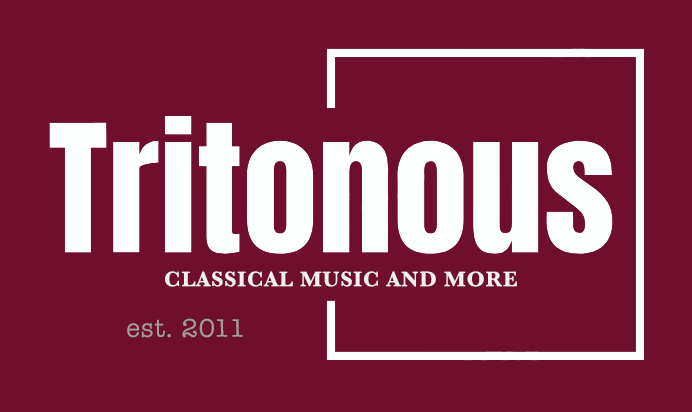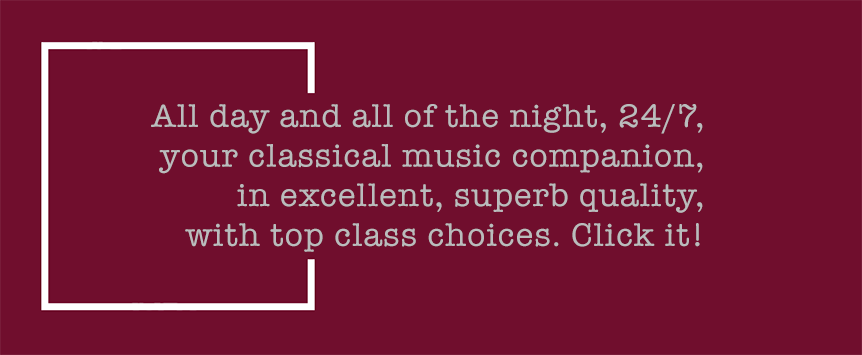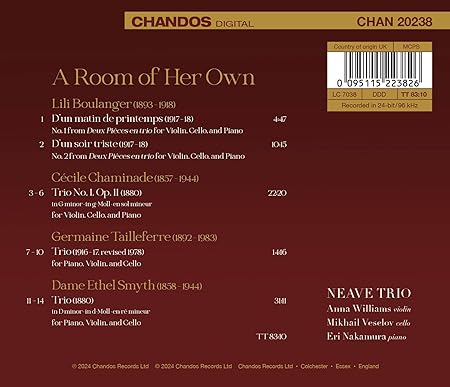The program certainly begins promisingly as the Neave Trio bursts into the first of Boulanger’s Deux Pieces with great enthusiasm. It is a terrific concert opener – contemporary-sounding, full of life and brimming with vivacity. It is imaginatively scored, too, reminding me at times of Debussy. If only the second piece were as appealing. It is marked Lent Grave, and this group certainly doesn’t minimize that. It begins with a mesmerizing, plaintive cello solo, eventually joined by the violin. But the music soon becomes rather tough going as it agonizes with increasing intensity. The opening tunefulness turns unpleasantly tense with some disturbing, unmusical chords in the piano. The middle section relaxes, losing some momentum, before the intensity builds again. This goes on for over 10 minutes, which frankly is way too long – especially as it ends up being more than twice as long as the first piece.
After this, the Chaminade comes as a delightful respite. It is a refreshing breath of air – 22 minutes of pure, rhapsodic melodiousness. The tunes never cease from this wonderful composer, and she positively fills the work with endless inspiration. But it’s never sappy or oversweet; it is at all times heartfelt and sincere, with an absorbing variety of mood and atmosphere. Best of all, she is a master at orchestration for this particular trio of instruments, with transparent textures and light and shade coloring.
The opening Allegro takes flight with soaring lines and rich harmonies, gloriously played by the Neave Trio, while the Andante features rhapsodic, singing lines from the violin and cello, back and forth in impassioned conversation. The piano is featured prominently throughout, with highly virtuosic writing nearly everywhere – especially in the 3rd movement Scherzo, where the bravura piano figuration and filigree fly off the page like a whirlwind – but gossamer and light as a feather. It is brilliantly played by the Neave pianist, Eri Nakamura. The finale, too, is a tour de force, reminding me at times of Litolff’s famous Scherzo.
The Chaminade is so thoroughly wonderful, I was reluctant to forge ahead. And predictably, the Tailleferre isn’t quite as rewarding, compositionally or musically. It’s a rather unusual piece, sounding at times more contemporary, and others steadfastly traditional. I found it interesting reading in the booklet (after the fact) that Tailleferre revised the piece in 1978 – over 60 years after it was conceived! She replaced the second movement with a Scherzo and appended a newly composed final movement. And one can clearly hear the differences in creative style from section to section.
The opening Allegro animato is sweet and decidedly “French”. There is some adventurous harmonic progression in the piano writing, which sounds perfect for the period. The Allegro vivace is more modern-sounding, while the central Moderato returns us to the lyricism of the first movement. The finale is certainly the best of all, starting with a flurry of activity, again sounding more modern (and a bit like Debussy). It is compelling and attractive – especially as played with such vitality by the Neave Trio.
I sometimes felt the piece wasn’t quite as expertly scored for piano trio, though. The cello contribution seems slightly understated – so much that at times I really had to listen for it (perhaps partly due to the recording balance). I occasionally found myself thinking this was a Violin/Piano Sonata and checked the program listing more than once to confirm it was indeed a Trio. However, Tailleferre knew when to stop, at just under 15 minutes, which is just about right.
The concluding work by English composer Ethel Smyth is monumental in comparison – lasting over 30 minutes! And as good as it is, it does tend to go on rather too long. The opening Allegro non troppo immediately immerses us into the heavily-laden Romanticism of Brahms. But some sweetly singing violin lines and delightful lightness in the piano playing help to minimize any undue heaviness. (I really do like this pianist.) And I love the passages where Smyth flourishes with a truly distinctive voice.
If there is no escaping Brahms in the Andante, it sings with marvelous sweetness as played here by violinist Anna Williams, and the contrasting central scherzando section is delightful. The Scherzo presto con brio, on the other hand, actually sounds like Albeniz (and even a bit like Liszt ) with its scintillating, rapid repeated notes in the piano, answered by the strings. But even here, Brahms soon takes over, tending to add unnecessary weight to it. The final Allegro is similar, heavy with his influence. And curiously, the Neaves avoid the vivace indication here, emphasizing instead its rapturous harmonies and soaring lines, adding an extra measure of grandeur.
Typical of Smyth’s style, I miss a bit of variety and light and dark shading of textures. This is serious business for her. Don’t think for a moment Ethel Smyth allows a “feminine” lightheartedness to imbue her music. Instead, it is unabashedly infused with Brahms in every phrase, and the Neave Trio do their very best to bring out the best of both worlds.
Taken as a whole, I found this program rather too much for one sitting. There is a bit of routine and sameness to it when listening to all 83 minutes (!) at once. However, one certainly can’t fault the playing of the Neave Trio, which is excellent, as is the Chandos recording – although it should be noted this is a standard stereo CD, rather than their usual multichannel SACD.
I thought it was interesting the Chandos cover lists the composers in a different order from how their music is laid out on the CD. And the order on the front is exactly how I like them from best to least. Smyth’s Trio certainly has much to enjoy, and I began to appreciate the Tailleferre more and more with repeated listening. But it is the Chaminade which is the undisputed standout of the program, and it alone compensates for any shortcomings from the rest.









